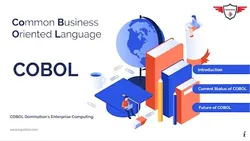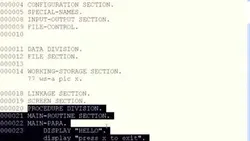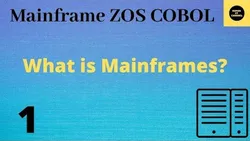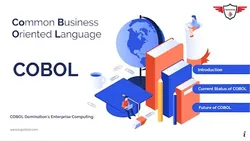
Mainframe COBOL Tutorial 
This course provides an introduction to the COBOL language, its dominance in the mainframe world, and its history. It covers data types, the evaluate statement, and the redefines clause. It also provides a quick guide to evaluating in COBOL, evaluation examples, and renaming rules. Students will gain a comprehensive understanding of the language. ▼
ADVERTISEMENT
Course Feature
![]() Cost:
Cost:
Free
![]() Provider:
Provider:
Youtube
![]() Certificate:
Certificate:
Paid Certification
![]() Language:
Language:
English
![]() Start Date:
Start Date:
On-Demand
Course Overview
❗The content presented here is sourced directly from Youtube platform. For comprehensive course details, including enrollment information, simply click on the 'Go to class' link on our website.
Updated in [May 25th, 2023]
This Mainframe COBOL Tutorial course provides an introduction to the COBOL language, its dominance in the industry, and its history. It covers the different data types in COBOL, such as alphanumeric, numeric, and PIC- Z X 9. It also provides a quick guide to the Evaluate statement in COBOL, as well as examples of evaluating and redefining clauses. Finally, it covers renaming rules in COBOL.
[Applications]
After completing this course, students should be able to apply their knowledge of COBOL to develop and maintain mainframe applications. They should be able to use the COBOL language to create and manipulate data types, use the EVALUATE statement, and use the REDEFINES and RENAMES clauses. Additionally, they should be able to understand the history and dominance of COBOL in the mainframe world.
[Career Paths]
1. Mainframe COBOL Developer: Mainframe COBOL developers are responsible for developing, testing, and maintaining software applications written in COBOL. They must have a strong understanding of the language and be able to write efficient code. As the demand for mainframe applications continues to grow, the need for experienced mainframe COBOL developers is increasing.
2. Mainframe COBOL Analyst: Mainframe COBOL analysts are responsible for analyzing and troubleshooting existing COBOL applications. They must have a deep understanding of the language and be able to identify and resolve any issues that arise. As the demand for mainframe applications continues to grow, the need for experienced mainframe COBOL analysts is increasing.
3. Mainframe COBOL Consultant: Mainframe COBOL consultants are responsible for providing advice and guidance to organizations on how to best utilize COBOL. They must have a strong understanding of the language and be able to provide advice on how to optimize existing applications and develop new ones. As the demand for mainframe applications continues to grow, the need for experienced mainframe COBOL consultants is increasing.
4. Mainframe COBOL Trainer: Mainframe COBOL trainers are responsible for teaching and training individuals on how to use COBOL. They must have a strong understanding of the language and be able to provide instruction on how to write efficient code. As the demand for mainframe applications continues to grow, the need for experienced mainframe COBOL trainers is increasing.
[Education Paths]
1. Bachelor of Science in Computer Science: This degree path provides students with a comprehensive understanding of computer science, including programming languages, software engineering, computer networks, and operating systems. Students will learn the fundamentals of computer science and develop the skills necessary to design, develop, and maintain computer systems. Additionally, this degree path will provide students with the knowledge and skills to pursue a career in the field of computer science.
2. Bachelor of Science in Information Technology: This degree path focuses on the application of technology to solve business problems. Students will learn the fundamentals of information technology, including database management, web development, and network security. Additionally, this degree path will provide students with the knowledge and skills to pursue a career in the field of information technology.
3. Master of Science in Computer Science: This degree path provides students with an advanced understanding of computer science, including artificial intelligence, machine learning, and computer vision. Students will learn the fundamentals of computer science and develop the skills necessary to design, develop, and maintain complex computer systems. Additionally, this degree path will provide students with the knowledge and skills to pursue a career in the field of computer science.
4. Master of Science in Information Technology: This degree path focuses on the application of technology to solve complex business problems. Students will learn the fundamentals of information technology, including data analytics, cloud computing, and software engineering. Additionally, this degree path will provide students with the knowledge and skills to pursue a career in the field of information technology.
The development trends for these degree paths are focused on the use of emerging technologies such as artificial intelligence, machine learning, and cloud computing. Additionally, the focus is on the application of technology to solve complex business problems. As technology continues to evolve, these degree paths will continue to be in high demand.
Course Provider

Provider Youtube's Stats at AZClass
Discussion and Reviews
0.0 (Based on 0 reviews)
Explore Similar Online Courses

The Complete Trading Course (Beginners To Trader)

From Zero to Hero in Elixir

Python for Informatics: Exploring Information

Social Network Analysis

Introduction to Systematic Review and Meta-Analysis

The Analytics Edge

DCO042 - Python For Informatics

Causal Diagrams: Draw Your Assumptions Before Your Conclusions

Whole genome sequencing of bacterial genomes - tools and applications

COBOL

Mainframe COBOL


Start your review of Mainframe COBOL Tutorial